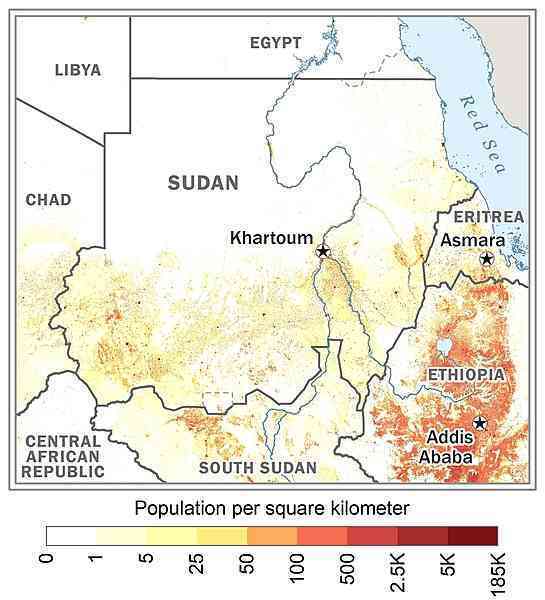
north-eastern Africa, bordering the Red Sea, between Egypt and Eritrea
15 00 N, 30 00 E
Africa
total: 1,861,484 sq km
land: 1,731,671 sq km
water: 129,813 sq km
slightly less than one-fifth the size of the US
total: 6,819 km
border countries (7): Central African Republic 174 km; Chad 1,403 km; Egypt 1,276 km; Eritrea 682 km; Ethiopia 744 km; Libya 382 km; South Sudan 2,158 km
note: Sudan-South Sudan boundary represents 1 January 1956 alignment; final alignment pending negotiations and demarcation; final sovereignty status of Abyei region pending negotiations between Sudan and South Sudan
853 km
territorial sea: 12 nm
contiguous zone: 18 nm
continental shelf: 200-m depth or to the depth of exploitation
hot and dry; arid desert; rainy season varies by region (April to November)
generally flat, featureless plain; desert dominates the north
highest point: Jabal Marrah 3,042 m
lowest point: Red Sea 0 m
mean elevation: 568 m
petroleum; small reserves of iron ore, copper, chromium ore, zinc, tungsten, mica, silver, gold; hydropower
agricultural land: 100% (2018 est.)
arable land: 15.7% (2018 est.)
permanent crops: 0.2% (2018 est.)
permanent pasture: 84.2% (2018 est.)
forest: 0% (2018 est.)
other: 0% (2018 est.)
15,666 sq km (2020)
An Nīl (Nile) (shared with Rwanda [s], Tanzania, Uganda, South Sudan, and Egypt [m]) - 6,650 km; Blue Nile river mouth (shared with Ethiopia [s]) - 1,600 km
note – [s] after country name indicates river source; [m] after country name indicates river mouth
Atlantic Ocean drainage: (Mediterranean Sea) Nile (3,254,853 sq km)
Internal (endorheic basin) drainage: Lake Chad (2,497,738 sq km)
Nubian Aquifer System, Sudd Basin (Umm Ruwaba Aquifer)
with the exception of a ribbon of settlement that corresponds to the banks of the Nile, northern Sudan, which extends into the dry Sahara, is sparsely populated; more abundant vegetation and broader access to water increases population distribution in the south extending habitable range along nearly the entire border with South Sudan; sizeable areas of population are found around Khartoum, southeast between the Blue and White Nile Rivers, and throughout South Darfur as shown on this 
dust storms and periodic persistent droughts
the Nile is Sudan's primary water source; its major tributaries, the White Nile and the Blue Nile, meet at Khartoum to form the River Nile which flows northward through Egypt to the Mediterranean Sea
NOTE: The information regarding Sudan on this page is re-published from the 2024 World Fact Book of the United States Central Intelligence Agency and other sources. No claims are made regarding the accuracy of Sudan 2024 information contained here. All suggestions for corrections of any errors about Sudan 2024 should be addressed to the CIA or the source cited on each page.
This page was last modified 04 May 24, Copyright © 2024 ITA all rights reserved.